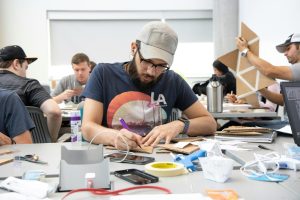Augmented Reality in Language Learning: Interactive Language Immersion
Language learning has come a long way from traditional methods of textbooks and memorization. With the advancements in technology, innovative tools and techniques have emerged to make language learning more interactive and engaging. One such technology that has been making waves in the education industry is augmented reality (AR). Augmented reality in language learning offers an immersive and interactive experience, making the learning process more effective and enjoyable. In this article, we will explore how augmented reality is revolutionizing language learning through interactive language immersion.
The Rise of Augmented Reality in Language Learning
Evolving from Traditional Language Learning Methods
Traditional methods of language learning often include textbooks, writing exercises, and repetitive drills. While these methods are proven to be effective, they can also be monotonous and disengaging. With the rise of technology, language learning has undergone a significant transformation. Online courses, language learning apps, and immersive experiences have made language learning more accessible, convenient, and interesting.
One of the most exciting technological advancements in language learning is augmented reality. Augmented reality creates a digital overlay on the real world, allowing learners to interact with virtual objects and characters.
Creating an Immersive Learning Environment
Augmented reality in language learning offers a unique and immersive learning experience. Learners are transported to a virtual environment where they can interact with objects, characters, and scenarios, making the learning process more engaging and memorable. This immersive experience allows learners to practice real-life situations, such as ordering food at a restaurant or having a conversation with a native speaker.
Moreover, augmented reality allows learners to see the direct application of the language they are learning. By interacting with virtual objects and scenarios, learners can understand the practical use of the language, making it more relevant and meaningful.
The Benefits of Augmented Reality in Language Learning
Improves Understanding and Retention
One of the significant benefits of augmented reality in language learning is its ability to improve understanding and retention. By creating an immersive learning experience, learners are more likely to retain the language they are learning. With the combination of visual and interactive elements, learners are engaged on multiple levels, making it easier for them to grasp and remember the language.
Moreover, augmented reality allows learners to see real-life application and context, making the language learning process more relatable and realistic. As a result, learners are more motivated to continue learning and improve their skills.
Encourages Active Learning
Traditional methods of language learning often rely on passive learning, where learners are expected to sit and listen to lectures or repeat phrases. However, augmented reality encourages active learning by allowing learners to interact with virtual objects and characters. This hands-on approach not only makes learning more enjoyable but also promotes active learning, which has been proven to be more effective in retaining information.
Personalized Learning Experience
Another advantage of augmented reality in language learning is its ability to provide a personalized learning experience. With augmented reality, learners can choose the level of difficulty and pace of their learning. They can also receive immediate feedback and track their progress, making the learning process more tailored to their needs and abilities.
The Future of Language Learning with Augmented Reality
As technology continues to advance, so will the possibilities for language learning. Augmented reality is constantly evolving and providing new ways to create an immersive and interactive learning environment. With the rapid growth of mobile devices, augmented reality has become more accessible, making it easier for learners to incorporate into their language learning journey.
Furthermore, augmented reality has endless potential for collaboration and community learning. Learners from all over the world can connect and practice their language skills in a virtual environment, further enhancing their learning experience and cultural understanding.
Conclusion
Augmented reality is transforming the way we learn languages, making it more engaging, interactive, and efficient. Through interactive language immersion, learners can improve their understanding, retention, and motivation to continue learning. As technology continues to advance, the possibilities for augmented reality in language learning are endless, and its potential for creating a global community of language learners is both exciting and promising.









